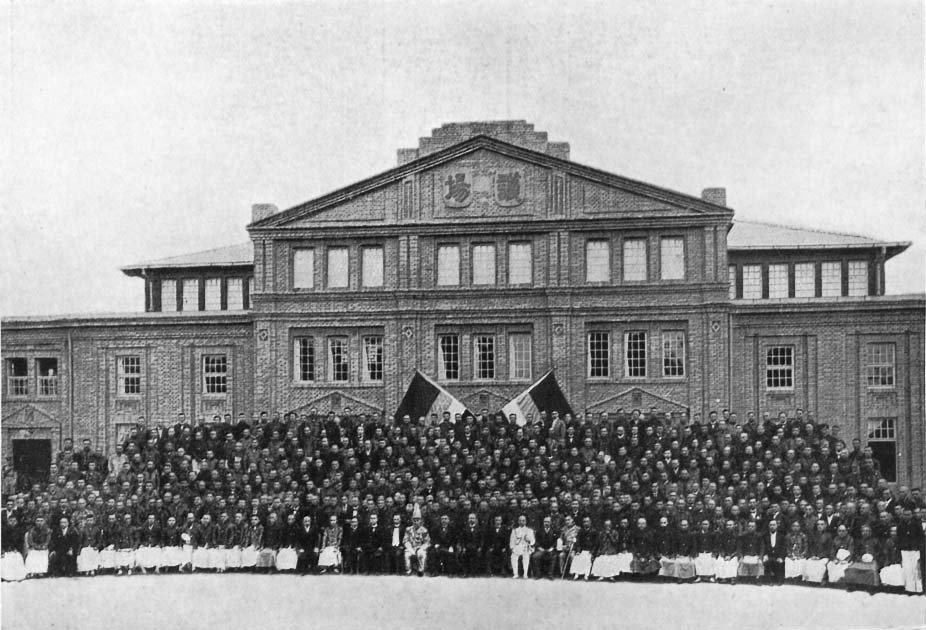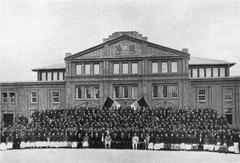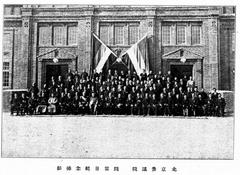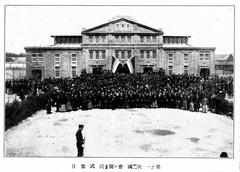
National Assembly Building Beijing: Visiting Hours, Tickets, and Historical Sites Guide
Date: 15/06/2025
Introduction
Beijing, the bustling capital of China, is a city steeped in history and political transformation. Among its most intriguing historical sites is the National Assembly Building, a monument that encapsulates China’s early 20th-century aspirations for constitutional governance following the end of imperial rule. Though now part of the Xinhua News Agency compound and largely closed to the public, the building remains an enduring symbol of the nation’s journey toward modern statehood (Wikipedia).
This guide explores the National Assembly Building’s origins, architectural features, and political significance, while offering practical travel advice, including information on access, special events, and nearby attractions like Tiananmen Square and the Great Hall of the People. Whether you’re a history enthusiast or a visitor seeking to understand Beijing’s complex heritage, this article provides essential insights and travel tips for exploring the city’s political landmarks (Wikiwand).
Table of Contents
- Early Republican Aspirations and the Birth of the National Assembly
- The Building’s Political Role During the Republican Era
- Architectural Significance and Symbolism
- Decline and Legacy of the National Assembly
- Visiting Information: Hours, Tickets & Accessibility
- Nearby Attractions and Photographic Spots
- Frequently Asked Questions (FAQ)
- Conclusion & Summary
- References and Further Reading
Early Republican Aspirations and the Birth of the National Assembly
The National Assembly Building was conceived during a period of profound change in China. In 1911, the Xinhai Revolution ended over two millennia of imperial rule, paving the way for the Republic of China. Reformers sought to establish a parliamentary system inspired by Western models, leading to the creation of a bicameral National Assembly (Wikipedia).
Construction of a grand parliamentary building began in 1910, with German architect Curt Rothkegel commissioned for the design. However, the revolution halted the project, leaving it unfinished. The need for a legislative venue persisted after the founding of the Republic, prompting the construction of the National Assembly Building (北京国会旧址) in Beijing. Rothkegel again played a central role in its design, infusing the structure with neoclassical elements that reflected the era’s hopes for democratic governance (Wikipedia).
Political Role During the Republican Era
The National Assembly Building served as the intermittent meeting place for the National Assembly, a body intended to anchor China’s new constitutional order. Despite its symbolic significance, the Assembly’s power was often challenged by military strongmen and political instability, especially during the Warlord Era (1916–1928) (Wikiwand).
The building witnessed moments of high drama, such as the first national elections and the Beijing Coup of 1924. However, the ambitions of the early republic were often thwarted by factionalism and external interference, limiting the Assembly’s effectiveness (Wikipedia).
Architectural Significance and Symbolism
Curt Rothkegel’s design for the National Assembly Building drew heavily on neoclassical architecture, symbolizing the ideals of order, democracy, and progress. The building’s columns and symmetrical proportions were intended to align China with the world’s constitutional nations.
Although the original grand parliament was never completed, the existing building stands as a rare example of early 20th-century governmental architecture in Beijing. It remains a physical testament to the optimism and challenges of the Republican era (Wikipedia).
Decline and Legacy of the National Assembly
The National Assembly’s influence faded as the Republic of China’s central authority weakened. After the Nationalist government relocated to Nanjing and then to Taiwan, the Assembly in Beijing ceased to function. The first post-war National Assembly convened in Nanjing in 1948, but the Communist victory in 1949 led to the Assembly and government’s relocation to Taipei (Wikiwand).
In Taiwan, the Assembly continued with diminishing powers until its formal dissolution in 2005 (Wikipedia). In Beijing, the original building became part of the Xinhua News Agency compound, no longer serving its legislative purpose but standing as a witness to a pivotal chapter in Chinese history.
Visiting Information: Hours, Tickets & Accessibility
Visiting Hours
The National Assembly Building is not open for routine public visits, as it is within the Xinhua News Agency compound. Access is sometimes permitted during special exhibitions or official events.
Ticket Information
There are no regular tickets or public entry. For opportunities to visit during special events, monitor Xinhua News Agency’s announcements or contact their press office.
Accessibility
The building is centrally located in Beijing, easily reached by public transportation. The nearest subway stations and bus routes provide access to the surrounding area. While entry is restricted, visitors can view and photograph the building’s exterior from public spaces.
Travel Tips
- Plan your visit around special events that may allow limited access.
- Combine your trip with nearby attractions such as Tiananmen Square and the Great Hall of the People.
- Use public transportation to navigate central Beijing efficiently.
Nearby Attractions and Photographic Spots
- Tiananmen Square: One of the world’s largest public squares, steeped in history.
- Great Hall of the People: The current seat of China’s legislature, a masterpiece of socialist-era architecture.
- Xinhua History Exhibition Hall: Displays the evolution of China’s official news agency.
The National Assembly Building’s neoclassical façade offers striking photo opportunities, especially in the context of Beijing’s surrounding Republican-era architecture.
Frequently Asked Questions (FAQ)
Q: Is the National Assembly Building open to the public?
A: No, it is generally closed except for special events organized by Xinhua News Agency.
Q: How can I visit the National Assembly Building?
A: Monitor official channels for special event announcements that may permit entry.
Q: Are guided tours available?
A: No regular tours are offered, but some historical tours of the area may include information about the building.
Q: Where can I buy tickets?
A: No tickets are sold for general admission.
Q: What landmarks are nearby?
A: Tiananmen Square, the Great Hall of the People, and the Xinhua History Exhibition Hall.
The Great Hall of the People: Visitor Guide
Introduction
On the western edge of Tiananmen Square stands the Great Hall of the People (人民大会堂), an enduring symbol of China’s political and cultural identity. Completed in 1959, it serves as the venue for the National People’s Congress and state ceremonies, and is one of Beijing’s top historical sites (TravelChinaGuide).
Visiting Hours and Tickets
- Hours: Generally open to the public from 9:00 AM to 2:00 PM on weekdays when not in official use. Closed during major events.
- Tickets: Admission is approximately 30 RMB. Tickets are sold at the entrance or via authorized agencies; cash is preferred. Reserve in advance if possible, especially during peak seasons (TravelChinaGuide).
- Guided Tours: Available in Mandarin and occasionally in English. Tours last 45–60 minutes and cover significant halls and the building’s history. Advance booking is recommended.
Accessibility and Facilities
- Location: 2 West Chang’an Avenue, Xicheng District, Beijing. Easily accessed by subway (Tiananmen West, Line 1).
- Security: Visitors must pass security checks and carry ID. Photography is restricted inside main halls.
- Disability Access: Ramps, elevators, and accessible restrooms are available, though some areas may be limited. Contact ahead for special assistance.
Travel Tips
- Dress smart casual; avoid shorts and flip-flops.
- Arrive early for security checks.
- Carry your passport for entry and ticket collection.
- Photography is generally not allowed inside main halls.
- Use public transportation to avoid traffic and road closures.
Nearby Attractions
- Tiananmen Square
- National Museum of China
- Mao Zedong Memorial Hall
- The Forbidden City (TravelChinaGuide)
Conclusion & Summary
The National Assembly Building remains a powerful emblem of China’s early republican ambitions, even as its legislative function has long since ceased. Its proximity to Tiananmen Square and the Great Hall of the People provides visitors with a unique lens into China’s political evolution and architectural heritage. While public access is limited, the building’s historical significance endures, and its location allows for an enriching exploration of Beijing’s political landmarks (Wikipedia; TravelChinaGuide).
For an optimal experience, combine your visit with tours of the Great Hall and surrounding attractions. Stay informed about special access opportunities through official channels, and use public transportation for convenience. To keep updated, download the Audiala app and follow our social media channels for the latest travel information and exclusive content on Beijing’s historical sites (Wikiwand).
References and Further Reading
- National Assembly Building (Beijing), Wikipedia, 2024
- National Assembly (Republic of China), Wikiwand, 2024
- Great Hall of the People, TravelChinaGuide, 2024
- Great Hall of the People, Wikipedia, 2024
- Beijing Government Ticketing, 2024
- BPA Studies, Big Leap Forward Era Architecture, 2024
- China Highlights – Beijing Attractions, 2024
















































